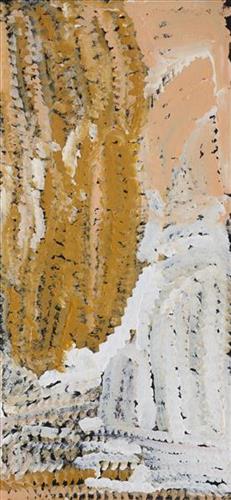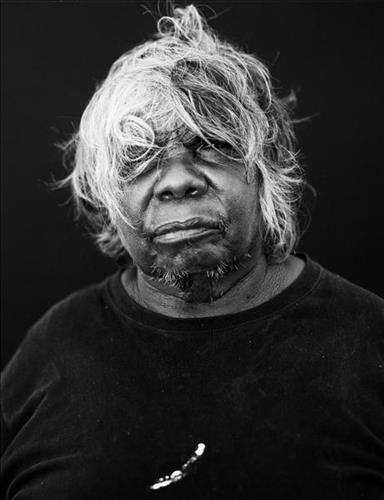Biography:
“When I was little, I used to stand up all the time, looking for the old people to come back bringing food. The old people gave me that name, Nyanjilpayi [‘standing up’].”
- Nyanjilpayi (Ngarnjapayi) Nancy Chapman
"When I was born my spirit appeared at Jarntinti. That's my Country, Jarntinti. I know all about it, about that water over there, about my home, our grandparent's Country. We travelled all around as pujiman, camping and then setting off again by foot. We didn't get tired. We just kept on going. Sometimes it would rain, so we would build a shelter, just like a tent. Inside we would light a fire. Our pujiman lifestyle was very healthy and we didn't get sick very often. Even when it was cold we continued to walk around in good health.
I'm working on my painting of those waterholes, I was drinking from them long ago as a pujiman. My family's water, my grandmother's, my grandfathers and my ancestors. I was taught from them. Our knowledge is ancient and has been passed on by our grandparents. Young people need to keep looking after it."
- Nyanjilpayi Nancy Chapman as translated by Kanyirninpa Jukurrpa
Nyanjilpayi is a Manyjilyjarra woman, born in the 1940s at Jarntinti, a large claypan at the southern end of Nyayartakujarra (Lake Dora) and within the Karlamilyi (Rudall River) region. She is the sister of fellow senior Martumili Artists Mulyatingki Marney, Mayiwalku Chapman and Marjorie Yates (dec.). As children, Nyanjilpayi and her family walked around the Punmu, Kunawarritji (Canning Stock Route Well 33) and Karlamilyi regions. A severe and prolonged drought extended through many years during this formative period in her life, and Nyanjilpayi remembers this as a difficult time. Although her family knew about the mission at Jigalong, where a supply of rationed food and water was assured, they chose to continue to live nomadically and independently for many years.
Both of Nyanjilpayi’s parents passed away when she and her siblings were still very young, leaving them to survive by themselves in the desert. For a time the sisters travelled alone, occasionally meeting and travelling with other people and family groups that cared for them, including renowned artists Eubena Nampitjin (dec.) and Nora Nungabar (Nyangapa) (dec.).
Finally Nyanjilpayi and her sisters decided to walk to Balfour Downs, where they were collected by Jigalong Mission staff. At Jigalong Nyanjilpayi met her husband Minyawe Miller. From there the couple lived and worked together on several cattle stations throughout the Pilbara, and mined for minerals with a yandy (winnowing dish) whilst raising their children. As a family they relocated to Punmu Aboriginal community as foundational members during the ‘Return to Country’ movement of the 1980’s, where they lived for many years before moving between Newman and Port Hedland in more recent times.
Nyanjilpayi is one of Martumili’s pioneering artists. She is known for her energetic, diverse, and experimental approach to painting, and has developed a range of unique and technically sophisticated styles. Nyanjilpayi’s artworks depict her ngurra (home Country, camp), the Country she walked as a young woman; its animals, plants, waterholes and associated Jukurrpa (Dreaming) narratives. Her work has been exhibited widely across Australia and internationally, and acquired by the National Museum of Australia.




